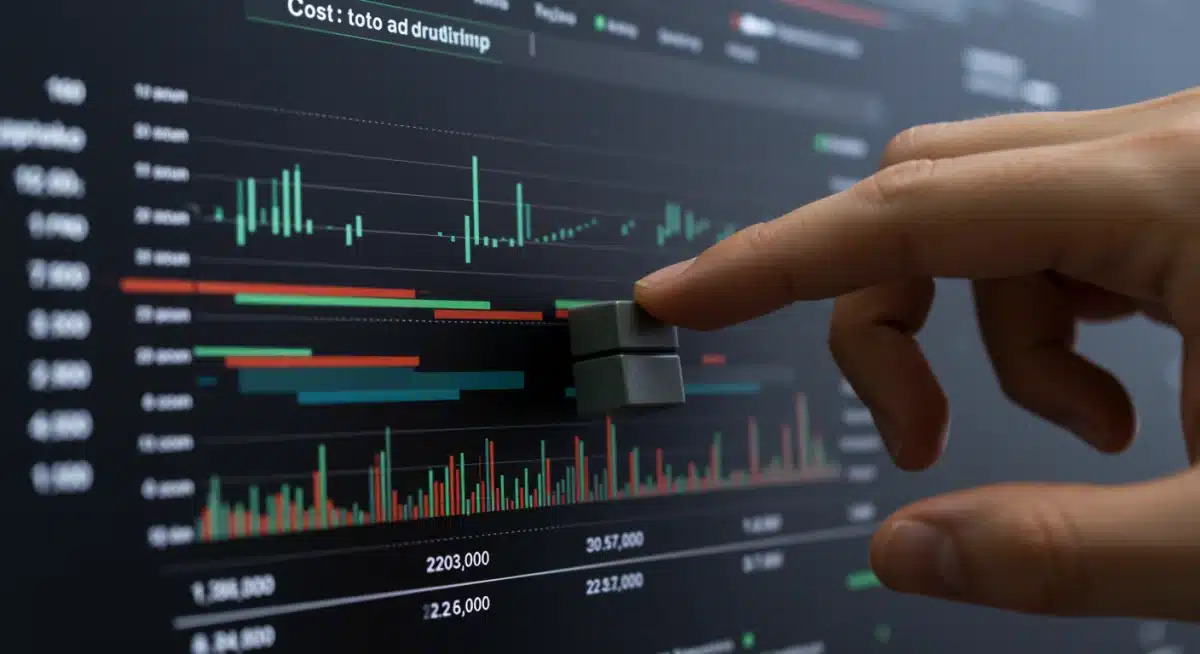Maximize Digital Ad Spend: Cut Costs 10% in US Market

Maximizing your digital ad spend and cutting costs by 10% in the current US market is critical for businesses seeking enhanced financial performance amidst evolving economic landscapes.
In today’s dynamic US market, businesses face increasing pressure to optimize every dollar spent. The challenge of maximizing your digital ad spend while simultaneously cutting costs by 10% has become a critical financial imperative for survival and growth. This report outlines immediate strategies to achieve significant savings and improve return on investment.
Understanding the Current Digital Ad Landscape
The US digital advertising market is experiencing rapid shifts, characterized by increased competition, rising cost-per-click (CPC), and evolving privacy regulations. Businesses must adapt quickly to these changes to maintain efficiency. Analyzing current trends provides a foundational understanding for strategic adjustments.
Recent data indicates a continued upward trajectory in overall digital ad spending, yet many businesses are finding their budgets stretched thin. This necessitates a more granular approach to campaign management and performance measurement. Understanding where your ad dollars are currently allocated is the first step toward optimization.
Key Market Trends Impacting Ad Spend
Several factors are currently influencing the effectiveness and cost of digital advertising. Inflationary pressures and supply chain disruptions indirectly affect consumer behavior and, consequently, ad performance. Furthermore, increased adoption of AI in ad platforms changes how campaigns are managed and optimized.
- Rising Competition: More businesses are vying for the same digital real estate, driving up bid prices.
- Privacy Regulations: Changes like Apple’s ATT and the impending deprecation of third-party cookies impact targeting capabilities.
- Platform Algorithm Updates: Constant adjustments by major ad platforms require continuous strategy refinement.
- Economic Uncertainty: Consumers are more cautious, demanding higher relevance and value from ads.
Data-Driven Audience Targeting for Cost Efficiency
Effective audience targeting is paramount to maximizing your digital ad spend. By precisely identifying and reaching your most valuable customers, you can eliminate wasted impressions and significantly reduce costs. This involves leveraging first-party data and advanced analytics to refine audience segments.
Many companies are still relying on broad targeting parameters, leading to inefficient ad delivery. Shifting to a data-centric approach allows for hyper-segmentation, ensuring your message resonates with those most likely to convert. This precision is directly correlated with higher ROI and lower acquisition costs.
Leveraging First-Party Data
Your own customer data is an invaluable asset for targeting. It provides insights into purchase history, website behavior, and demographic information that third-party data cannot match. Building robust first-party data strategies is crucial in a privacy-first world.
- CRM Integration: Connect your customer relationship management system to ad platforms for seamless data flow.
- Website Analytics: Use tools like Google Analytics 4 to understand user journeys and identify high-intent segments.
- Email Lists: Segment email subscribers and use them for lookalike audiences or direct retargeting.
Beyond first-party data, employing advanced lookalike modeling can expand your reach to new, yet highly relevant, audiences. This involves feeding your best customer data into ad platforms to find new users with similar characteristics, optimizing your budget by focusing on high-potential prospects.
Optimizing Ad Creative and Landing Page Experience
Even with perfect targeting, poor ad creative or a subpar landing page can derail your efforts and inflate costs. High-performing creative captures attention and drives action, while an optimized landing page converts that interest into tangible results. These elements are critical for maximizing your digital ad spend.
A/B testing is not merely a suggestion but a necessity for creative and landing page optimization. Continuously experimenting with different headlines, visuals, calls-to-action (CTAs), and page layouts allows you to identify what truly resonates with your audience, leading to improved click-through rates (CTR) and conversion rates.
Crafting Compelling Ad Copy and Visuals
Your ad creative must be clear, concise, and compelling. It should immediately communicate your value proposition and encourage the desired action. Visuals play a significant role in grabbing attention, so ensure they are high-quality and relevant to your message.
- Benefit-Oriented Headlines: Focus on what the user gains, not just what you offer.
- Clear Calls-to-Action: Use strong, action-oriented verbs.
- High-Quality Imagery/Video: Visuals should be professional and engaging.
- A/B Test Variations: Continuously test different elements to find winning combinations.
The journey doesn’t end with the click. The landing page must provide a seamless and relevant experience. It should load quickly, be mobile-responsive, and directly address the promise made in the ad. A disjointed experience leads to high bounce rates and wasted ad budget, directly impacting your ability to cut costs by 10%.
Strategic Bid Management and Budget Allocation
Effective bid management and intelligent budget allocation are cornerstones of maximizing your digital ad spend. Without a strategic approach, budgets can quickly be depleted on underperforming campaigns or keywords. This requires constant monitoring and adjustment based on real-time performance data.
Automated bidding strategies offered by platforms like Google Ads and Meta Ads can be powerful allies when used correctly. However, they require careful setup and oversight to ensure they align with your cost-reduction goals. Manual adjustments, particularly for high-value keywords or specific audience segments, may still be necessary.

Implementing Smart Bidding Strategies
Choosing the right bidding strategy depends on your campaign objectives. For cost reduction, focusing on conversion-based bidding can be highly effective, as it optimizes for actions rather than just clicks or impressions.
- Target CPA (Cost Per Acquisition): Aims to get as many conversions as possible within a target cost per acquisition.
- Maximize Conversions: Automatically sets bids to get the most conversions within your budget.
- Enhanced CPC: Adjusts manual bids up or down based on the likelihood of a conversion.
Beyond bidding, regularly reviewing your budget allocation across different campaigns and channels is vital. Shift funds from underperforming areas to those delivering better ROI. This agile approach ensures that your ad spend is always directed towards the most profitable opportunities, directly contributing to the goal of cutting costs by 10%.
Leveraging Automation and AI for Efficiency Gains
The integration of automation and artificial intelligence (AI) into digital advertising workflows offers unprecedented opportunities for maximizing your digital ad spend. These technologies can handle repetitive tasks, analyze vast datasets, and make real-time optimizations that human marketers simply cannot achieve at scale.
From automated reporting to dynamic creative optimization and predictive analytics, AI tools are transforming how campaigns are managed. By offloading these tasks to intelligent systems, marketing teams can focus on higher-level strategy and creative development, further enhancing efficiency and driving down costs.
AI-Powered Optimization Tools
Many ad platforms now embed AI directly into their core functionalities, providing smart recommendations and automated adjustments. Beyond platform-specific tools, third-party solutions offer even deeper insights and greater control over complex campaigns.
- Automated Bidding: As mentioned, AI-driven bidding strategies can optimize for specific goals.
- Dynamic Creative Optimization (DCO): AI can assemble ad variations in real-time based on user preferences.
- Predictive Analytics: Forecast future performance and identify potential issues before they impact budget.
- Automated Reporting and Insights: Generate performance reports and highlight key trends without manual effort.
Embracing AI and automation isn’t just about saving time; it’s about making smarter, data-driven decisions at a scale previously impossible. This leads to more effective campaigns, reduced waste, and a clear path to achieving and exceeding the 10% cost reduction target in the US market.
Continuous Monitoring, Reporting, and Iteration
Achieving and sustaining cost reductions in digital advertising is an ongoing process that demands continuous monitoring, robust reporting, and a commitment to iterative improvement. The digital landscape is constantly evolving, and what works today may not work tomorrow. Therefore, consistent analysis is key to maximizing your digital ad spend.
Establishing clear KPIs (Key Performance Indicators) and regularly reviewing performance against these metrics allows businesses to quickly identify underperforming campaigns or areas of inefficiency. This proactive approach prevents significant budget drain and enables timely adjustments to strategy.
Establishing Key Performance Indicators (KPIs)
Selecting the right KPIs is crucial for evaluating the effectiveness of your ad spend. These metrics should directly align with your business objectives and provide a clear picture of ROI.
- Cost Per Acquisition (CPA): Measures the cost of acquiring a new customer or lead.
- Return on Ad Spend (ROAS): Calculates the revenue generated for every dollar spent on advertising.
- Click-Through Rate (CTR): Indicates the effectiveness of your ad creative and targeting.
- Conversion Rate: Shows the percentage of users who complete a desired action.
Regular reporting should go beyond simply presenting numbers. It should offer actionable insights and recommendations for optimization. This process of continuous iteration – test, measure, learn, adjust – is fundamental to not only cutting costs by 10% but also achieving sustained growth and efficiency in your digital advertising efforts within the competitive US market.
| Key Strategy | Brief Description |
|---|---|
| Data-Driven Targeting | Utilize first-party data and advanced analytics to precisely reach high-value audiences, minimizing wasted ad spend. |
| Creative & Landing Page Optimization | A/B test ad creatives and landing pages to ensure maximum engagement and conversion efficiency. |
| Strategic Bid Management | Implement smart bidding strategies and agile budget allocation to focus spend on top-performing campaigns. |
| Leverage Automation & AI | Integrate AI and automation tools for real-time optimizations, predictive analytics, and enhanced efficiency. |
Frequently Asked Questions About Digital Ad Spend Optimization
Optimizing digital ad spend can lead to an immediate reduction in wasted budget and an increase in campaign efficiency. Businesses often see improved ROI, lower customer acquisition costs, and better overall financial performance by reallocating resources effectively.
First-party data allows for highly precise audience targeting, reducing the need for broad, expensive campaigns. By understanding your existing customers better, you can create more relevant ads that convert at higher rates, thus lowering your cost per conversion and maximizing your digital ad spend.
AI automates complex tasks like bidding and optimization, analyzes vast datasets for insights, and predicts performance trends. This leads to more efficient budget allocation, real-time adjustments, and improved campaign effectiveness, all contributing to significant cost reductions.
Yes, a 10% cost reduction is a realistic and achievable goal for many businesses through strategic optimization. By implementing data-driven targeting, creative improvements, smart bidding, and leveraging automation, companies can often find significant efficiencies within their existing digital ad spend.
Digital ad campaigns should be monitored continuously, with detailed reviews conducted weekly or bi-weekly. The dynamic nature of the US market and ad platforms necessitates frequent analysis and iterative adjustments to ensure ongoing cost efficiency and optimal performance.
Looking Ahead: Sustaining Ad Spend Efficiency
The current imperative to cut digital ad costs by 10% is not a one-time event but a continuous journey. As the US market evolves with new technologies and consumer behaviors, businesses must remain agile and proactive. The strategies outlined here provide a robust framework, but their long-term impact hinges on a culture of constant learning and adaptation. Integrating these practices into your operational DNA ensures that maximizing your digital ad spend becomes a sustainable competitive advantage, driving financial health and resilience in an ever-changing economic climate.





